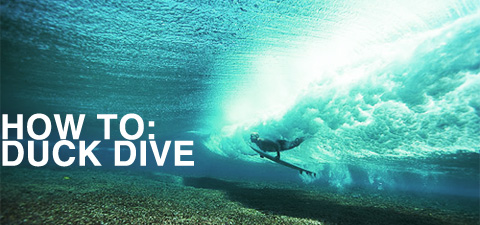Duck-diving is a technique to allow you to pass under breaking waves when paddling out, rather than getting hammered by each breaking wave. Duck-diving applies to shortboards which are smaller and lighter, for longboards there are a number of techniques used to achieve the same result. To duck-dive a shortboard, try to have as much paddling speed as possible when approaching the wave. At about two feet before making contact with the white water, grab both rails (edges of the surfboard) halfway between the nose and midpoint of your board. Push all your upper body weight onto your hands and arms until you feel the nose begin to go under. Point your head down and let your body follow. Once your body is just below the surface, bend your front leg and use that knee to push the tail under the wave. Your momentum should thrust you under the quickly passing wave and only require you to be under water for a short time. As the wave passes let the flotation of your board lift you to the surface. Now you have the skill to paddle to the lineup or to the next wave and duck under it.
For paddling out on a longboard there are a few ways of tackling the breaking waves: The slice and duck, Eskimo roll, push-ups and the shoot and scoot. On smaller waves the push-up technique is probably best. Just push up your chest and the wave will pass under your body and over the board. The shoot and scoot method is where you sit at the back of your board and sink the tail, grabbing the rails around the centre of the board so it raises above the oncoming wave. Don’t grab the surfboard at the nose or allow the nose to raise too much as you’ll flip the board. The Eskimo roll is the old school method of getting out back.
It’s simply a matter of grabbing the board and rolling it over so that the wave passes over the top of you. This is maybe not the most effective method as there is a chance you can get drilled by the wave and pushed further back to shore. The final method is the slice and duck which is executed by pushing down on one side of the surfboard so that it slices/sinks into the water, at the same time push down on the deck so that the board nose ducks under the water in the same way as a duck dive.


